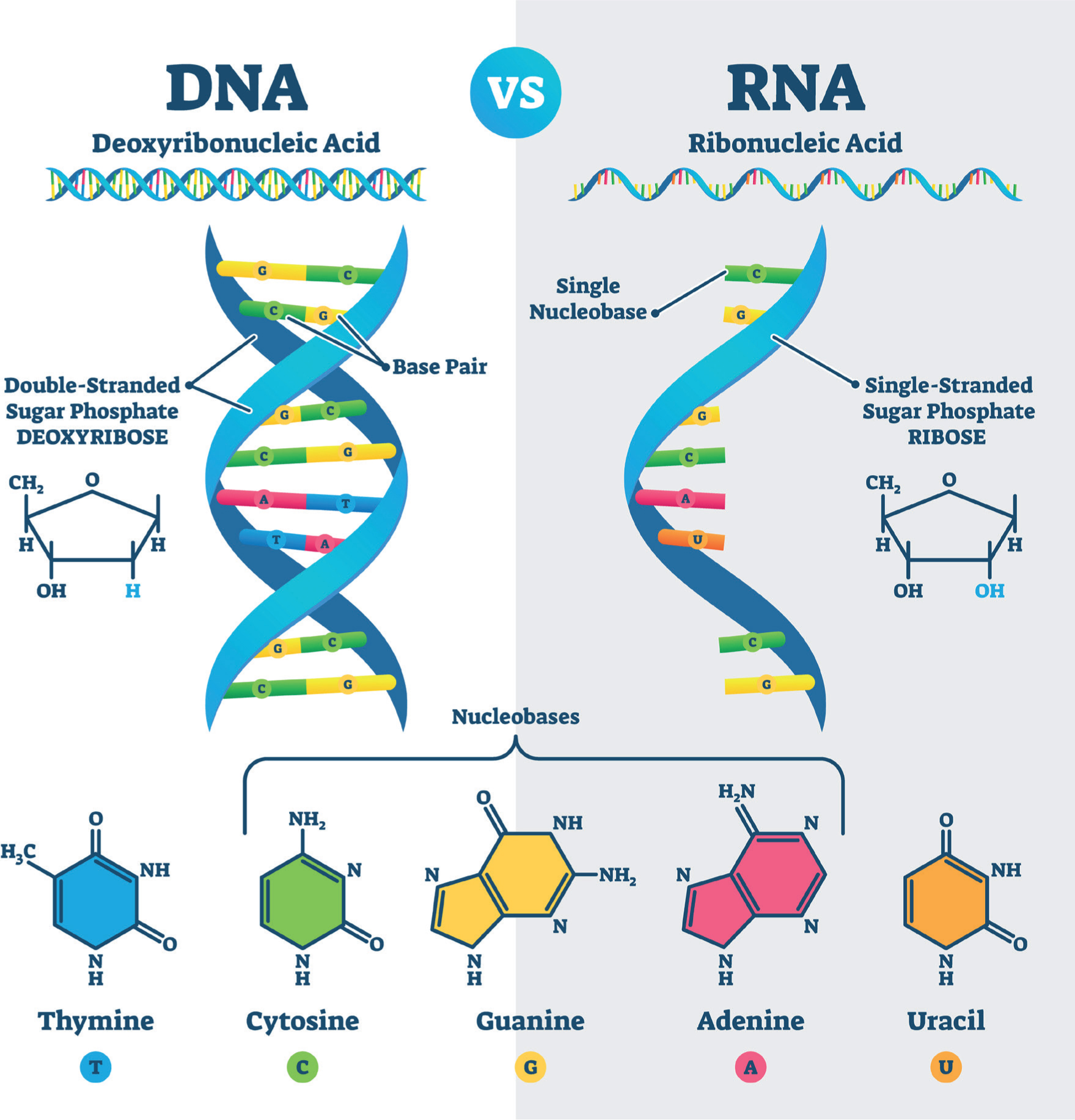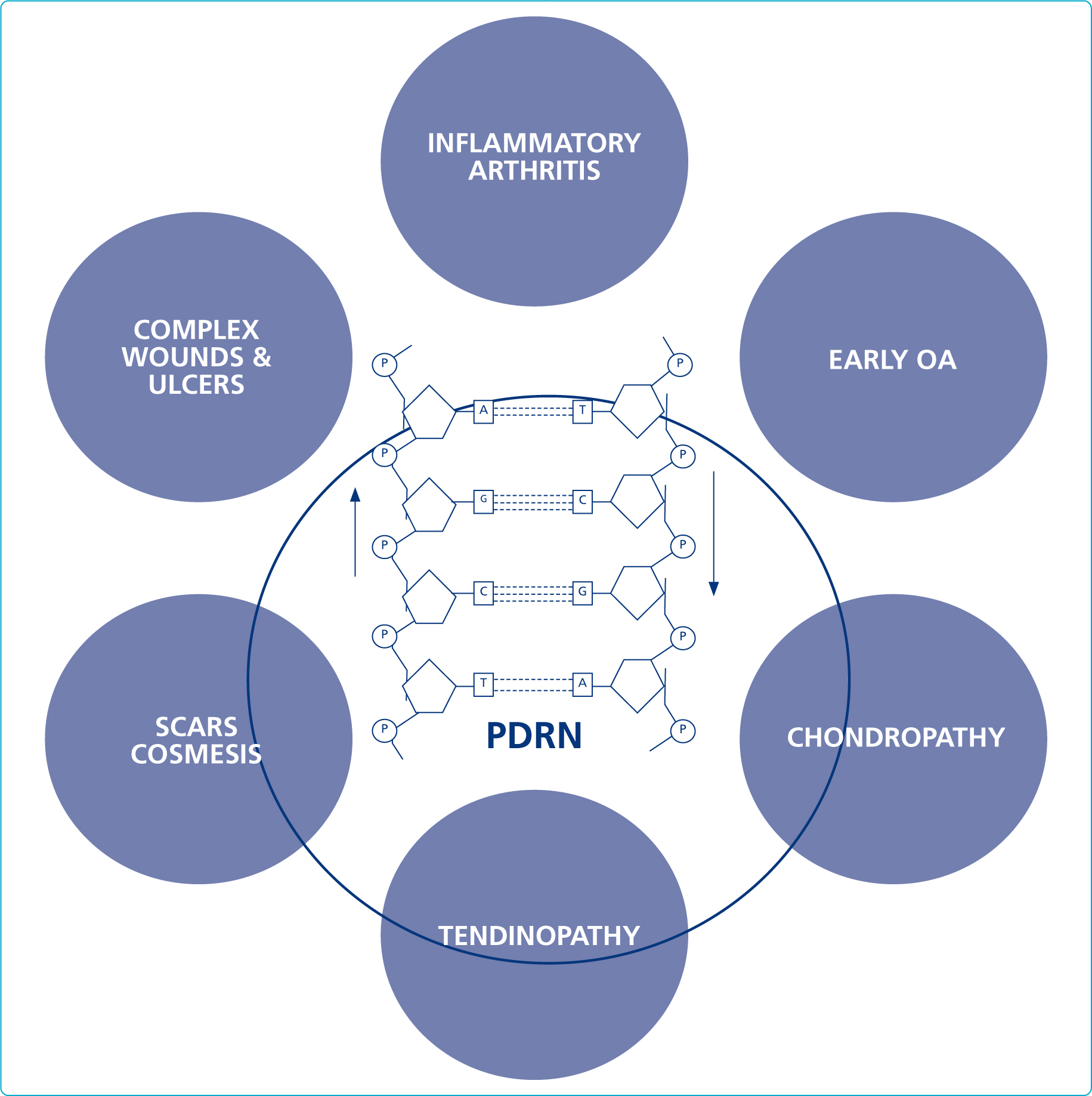
Polynucleotides are large biological molecules composed of a series of monomer units called nucleotides, each comprising a sugar (ribose or deoxyribose); a phosphate group; and a nitrogenous base (adenine, guanine, cytosine, thymine, or uracil). Each nucleotide is connected to the next by a phosphodiester bond, forming a chain that can be many millions of nucleotides long. The sequence of these bases along the polynucleotide chain constitutes the genetic code (Watson and Crick, 1953b; Watson and Crick, 1953a).
There are two main types of polynucleotides, DNA and RNA (Figure 1). DNA carries the genetic blueprint of life, holding the instructions necessary for an organism's development, survival, and reproduction. RNA, on the other hand, carries out the instructions encoded in DNA by synthesizing proteins, which are crucial to an organism's structure and function. The unique structure of polynucleotides allows for the replication and transmission of genetic information from generation to generation (Watson and Crick, 1953b; Watson and Crick, 1953a).

Given these molecules' fundamental role in biological function, it's not surprising that they have found extensive application in various aspects of medicine.
To note:
Polynucleotides:
Polynucleotides (PN) are macromolecules composed of nucleotide monomers joined together through phosphodiester bonds. Nucleotides consist of three components: a sugar molecule (ribose or deoxyribose), a phosphate group, and a nitrogenous base (adenine, thymine, cytosine, or guanine). When multiple nucleotides are linked together, they form a polynucleotide chain. Polynucleotides can be found in various forms, such as DNA (deoxyribonucleic acid) and RNA (ribonucleic acid), which play essential roles in storing and transmitting genetic information in living organisms. Licensed under medical devices.
» Polynucleotides, the key building blocks of life, have a fascinating history and broad range of applications spanning from the realm of medicine to aesthetics «
Polydeoxyribonucleotides:
Polydeoxyribonucleotides (PDRN) specifically refers to a mixture of deoxyribonucleotide polymers obtained from an extraction process, typically derived from a specific source, such as trout sperm. PDRN contains a combination of deoxyribonucleotides with varying chain lengths (ranging from 50 to 2000 base pairs).
While polynucleotides are a general term encompassing any polymer of nucleotides, Polydeoxyribonucleotide refers explicitly to a mixture of deoxyribonucleotide polymers obtained from a specific extraction process (Veronesi et al., 2017). Currently, PDRNs are utilised for treating diseases affecting bones, cartilage, and tendons. There's a notable variability in the dosage of PDRN used in clinical practice for these conditions, while the dosage for skin regeneration is well-defined. PDRNs are typically administered between three to five times, functioning through the activation of the A2A receptor (Veronesi et al., 2017, Lee et al., 2019). This is not a medical device.
The historical journey of polynucleotides to modern medicine
The discovery and understanding of polynucleotides have played a crucial role in shaping modern medicine. Johann Friedrich Miescher (a Swiss physician and biologist) first isolated ‘nuclein’ — now known as DNA, in the mid-19th century (Dahm, 2008). However, it was not until the early 20th century that scientists began to comprehend the polymeric nature of these molecules, leading to the term ‘polynucleotide’.
The significant breakthrough came in 1953 when James Watson and Francis Crick elucidated the double helical structure of DNA, revealing how genetic information is stored and replicated (Watson and Crick, 1953b; Watson and Crick, 1953a). This discovery marked the beginning of molecular biology and biotechnology, with polynucleotides at the heart of it all.
The subsequent decades witnessed the development of various technologies that harnessed the power of polynucleotides. From the invention of polymerase chain reaction (PCR) in the 1980s, which revolutionised the ability to analyse and manipulate DNA, to the sequencing of the human genome at the turn of the 21st century, polynucleotides have driven significant advances in biomedical research and medicine.
Sources
Polynucleotides can be sourced from various methods, each with its specific applications, advantages, and limitations. Here is a list of the sources of polynucleotides:
- In vitro enzymatic synthesis: This method uses enzymes like polynucleotide phosphorylase to synthesize polynucleotides in a laboratory setting. This enzymatic process can be controlled to produce polynucleotides with specific sequences or characteristics, making it a valuable method for producing customized polynucleotides for research or therapeutic applications (Grunberg-Manago et al., 1955, Grunberg-Manago and Ochoa, 1955).
- Chemical synthesis: Polynucleotides can be chemically synthesized in the lab. This method is often used for producing small to medium-length DNA or RNA sequences, such as those used in gene synthesis or the production of small interfering RNAs (siRNAs) for gene silencing applications (Reese, 1978, Reese, 2005, Ikehara et al., 1979).
- Natural sources - Animals: Long-chain polynucleotides can be extracted and purified from natural sources like salmon milt and sperm trout. These polynucleotides are processed and purified to be used as dermal fillers for skin rejuvenation (Schneider, 1952, Park et al., 2016, Altavilla et al., 2009). All polynucleotides used in aesthetic medicine are derived from salmon or trout.
- Natural sources - Bacteria: Certain bacteria like Azotobacter vinelandii have been used as a source of enzymes like polynucleotide phosphorylase, which can then be used for the enzymatic synthesis of polynucleotides (Katoh et al., 1973).
- Natural sources - Plants: Some plants may contain polynucleotides or related compounds with potential biotechnological applications (Souza et al., 2022). However, the extraction, purification, and utilization of plant-derived polynucleotides for therapeutic purposes is still an area of active research.
- Biotechnological methods: Polynucleotides can also be produced using biotechnological methods, which often involve the use of genetically engineered bacteria or yeast cells to produce large amounts of DNA or RNA. This method is often used for large-scale production of polynucleotides, such as those used in mRNA vaccines (Ashley et al., 2023, Pardi et al., 2020).
Each of these sources has specific advantages and limitations, and the choice of the source often depends on the specific application, the required sequence or length of the polynucleotide, and regulatory considerations. Regardless of the source, all polynucleotides intended for therapeutic use must undergo rigorous testing and quality control measures to ensure their safety and efficacy.
Polynucleotides in diagnostics
Polynucleotides have had a profound impact on diagnostic medicine. The ability to sequence and analyse DNA has led to the development of genetic testing, allowing for the identification of genetic mutations linked to specific diseases. This has proven invaluable for the early detection of inherited disorders, risk assessment for various diseases, and the tailoring of treatment strategies based on an individual's genetic profile, also known as precision medicine (Blauwkamp et al., 2019, Anzalone et al., 2022, Alphey, 2023).
PCR, a technique that amplifies specific DNA sequences, has found extensive use in pathogen detection, including the diagnosis of viral infections such as HIV and, more recently, SARS-CoV-2, the virus causing COVID-19 (Zhu et al., 2020, Cazzaniga et al., 2021).
Polynucleotides in therapeutics and regenerative medicine
The therapeutic potential of polynucleotides and polydeoxyribonucleotide have been the subject of extensive research over the past few decades, with reported benefits (Figure 2).

Gene therapy, a technique that uses polynucleotides to treat or prevent disease, has also come to fruition. By introducing, removing, or altering genetic material within a person's cells, it is possible to treat a wide range of genetic disorders, cancers, and viral infections (Basarkar and Singh, 2007, Conry et al., 1996). They have been used as adjuvants, substances that enhance the body's immune response to an antigen, improving the effectiveness of vaccines (Donnelly et al., 1996, Babiuk, 2003).
» Polynucleotides have demonstrated significant potential in regenerative medicine, including cellular reprogramming, stem cell engineering, and protein replacement therapy «

Polynucleotides have demonstrated significant potential in regenerative medicine, including cellular reprogramming, stem cell engineering, and protein replacement therapy (Kwon et al., 2018; Fang et al., 2015). Their inherent biological activity and their role as carriers of genetic information have made them a promising tool for stimulating tissue regeneration and healing (Sen, 2023).
Polydeoxyribonucleotide has been used for the treatment of chronic tendinosis (Yoon et al., 2017; Ryu et al., 2018). In a small study by Kim et al., the use of polydeoxyribonucleotide was reported as an ‘efficient and safe therapeutic option for the treatment of chronic plantar fasciitis’ (Kim and Chung, 2015). Furthermore, polydeoxyribonucleotide can induce therapeutic angiogenesis in peripheral artery occlusive disease and in diabetic foot ulcers. PDRN can enhance the production of vascular endothelial growth factor under conditions of insufficient tissue perfusion, typically observed during pathological situations. This effect is believed to occur by stimulating A2A receptors. PDRN has demonstrated effectiveness in experimental models of peripheral arterial occlusive disease, hind limb ischemia, impaired wound healing, and burn injuries (Altavilla et al., 2009).
» Their inherent biological activity and their role as carriers of genetic information have made them a promising tool for stimulating tissue regeneration and healing «
One example of their therapeutic application is in the treatment of osteoarthritis, a condition characterised by the degeneration of joint cartilage and the underlying bone. Dallari et al. conducted a randomised, double-blind, controlled clinical trial in which they assessed the efficacy of intra-articular injections of polynucleotides in combination with hyaluronic acid for knee osteoarthritis. The study concluded that the combination therapy was superior to the administration of hyaluronic acid alone, potentially indicating the regenerative abilities of the polynucleotides (Dallari et al., 2020).
This approach hinges on the ability of polynucleotides to stimulate the production of extracellular matrix components, aiding in the regeneration of damaged tissue. Furthermore, polynucleotides are thought to have anti-inflammatory properties, mitigating the inflammation that often exacerbates tissue damage. These characteristics make polynucleotides a promising treatment modality for a variety of degenerative conditions (Sen, 2023; Baek et al., 2018; Kim et al., 2018; Colangelo et al., 2020). The application of Polynucleotides Highly Purified Technology (PN-HPT®) has demonstrated efficacy in various clinical studies, showcasing its potential in the treatment of lower limb venous ulcers (speeds the healing rate), postmenopausal atrophic labia majora, and knee osteoarthritis through intra-articular infiltration (De Caridi et al., 2016; Palmieri and Raichi, 2019; Giarratana et al., 2014).
Polynucleotides in aesthetic medicine
The rise of non-invasive aesthetic treatments has paved the way for the use of polynucleotides in aesthetic medicine. Their biocompatibility, biodegradability, and regenerative properties make them ideal candidates for skin rejuvenation, revitalisation, priming prior to other treatments, scar management and hair growth treatments (Cavallini et al., 2021; Araco et al., 2023; Park et al., 2016; Cavallini et al., 2022; Rho and Chung, 2018).
One of the primary roles of polynucleotides in aesthetic medicine involves the stimulation of collagen synthesis. Collagen is a fundamental protein that provides strength and elasticity to the skin. As we age, collagen production declines, leading to the formation of wrinkles and other signs of aging. By boosting collagen production, polynucleotides help improve skin elasticity, reducing wrinkles and enhancing overall skin health.
A recent study investigates the effects of PN in stimulating the viability of human gingival fibroblasts in vitro. Polynucleotides demonstrate efficacy in stimulating the growth of primary gingival fibroblasts. Additionally, when combined with hyaluronic acid, they exhibit potent abilities to promote wound healing. These effects have been assessed in vitro, where polynucleotides have been found to stimulate cell growth and migration while facilitating the synthesis of endogenous collagen in the extracellular matrix (Colangelo et al., 2021).
In a small study carried out by Kim and colleagues, there were reported improvements in wrinkles, pores, texture, depression, and Hb level after polynucleotide filler for crow's feet (Kim et al., 2022).
A specific application of polynucleotides in aesthetic medicine is the treatment of acne scars. Acne is a common skin condition, and its healing process can leave behind scars that impact an individual's self-esteem and quality of life. Araco and Araco, in a preliminary study, have demonstrated that the use of highly purified polynucleotides could improve the appearance of moderate to severe acne scars, offering a promising accompaniment to traditional acne scar treatments (Araco and Araco, 2021). In a different study, they demonstrated rapid improvement of the skin dermis texture and quality in individuals with moderate to severe nasolabial folds (Araco et al., 2023).
» The rise of non-invasive aesthetic treatments has paved the way for the use of polynucleotides in aesthetic medicine. Their biocompatibility, biodegradability, and regenerative properties make them ideal candidates for skin rejuvenation, revitalisation, priming prior to other treatments, scar management and hair growth treatments «
Combination treatment of polynucleotides with other aesthetic interventions, including microneedling with radiofrequency, has shown promising results (Rho and Chung, 2018, Yogya et al., 2022, Angelucci et al., 2022). Furthermore, polynucleotides and PDRN can be used in scar prevention. In a randomised controlled trial, Kim and colleagues demonstrated that early postoperative injection of PDRN can help prevent hypertrophic scars and improve scar outcomes (Kim et al., 2018).

Conclusion
In conclusion, polynucleotides, the fundamental molecules of life, have had an extraordinary impact on the field of medicine, from diagnostics to therapeutics to aesthetics. Their historical journey from the first discovery of nuclein to their current pivotal role in medical science underscores their significance in advancing human health.
The future of polynucleotides in medicine looks bright. With technological advancements, such as CRISPR-Cas9 gene editing and mRNA vaccines, polynucleotides will continue to shape the medical landscape. However, as we continue to harness the power of these molecules, it will be essential to balance their potential benefits with ethical considerations while establishing evidence-based protocols.



